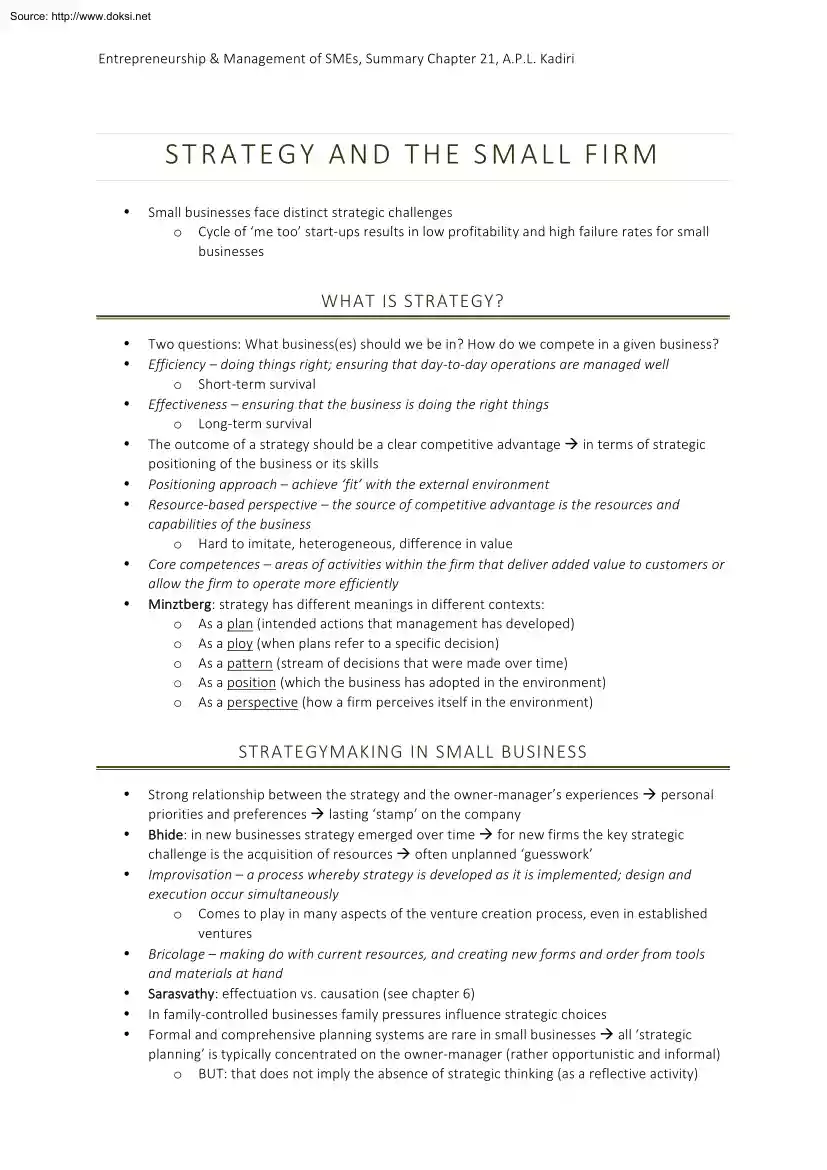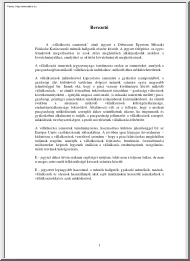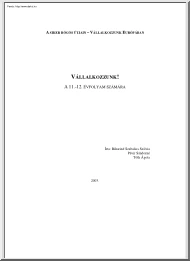Datasheet
Year, pagecount:2016, 5 page(s)
Language:English
Downloads:2
Uploaded:March 04, 2019
Size:516 KB
Institution:
-
Comments:
Attachment:-
Download in PDF:Please log in!
Comments
No comments yet. You can be the first!Most popular documents in this category
Content extract
Source: http://www.doksinet Entrepreneurship & Management of SMEs, Summary Chapter 21, A.PL Kadiri S T R A T E G Y A N D T H E S M A L L F I R M • Small businesses face distinct strategic challenges o Cycle of ‘me too’ start-‐ups results in low profitability and high failure rates for small businesses WHAT IS STRATEGY? • Two questions: What business(es) should we be in? How do we compete in a given business? • Efficiency – doing things right; ensuring that day-‐to-‐day operations are managed well o Short-‐term survival • Effectiveness – ensuring that the business is doing the right things
o Long-‐term survival • The outcome of a strategy should be a clear competitive advantage à in terms of strategic positioning of the business or its skills • Positioning approach – achieve ‘fit’ with the external environment • Resource-‐based perspective – the source of competitive advantage is the resources and capabilities of the business o Hard to imitate, heterogeneous, difference in value • Core competences – areas of activities within the firm that deliver added value to customers or allow the firm to operate more efficiently • Minztberg: strategy has different meanings
in different contexts: o As a plan (intended actions that management has developed) o As a ploy (when plans refer to a specific decision) o As a pattern (stream of decisions that were made over time) o As a position (which the business has adopted in the environment) o As a perspective (how a firm perceives itself in the environment) STRATEGYMAKING IN SMALL BUSINESS • Strong relationship between the strategy and the owner-‐manager’s experiences à personal priorities and preferences à lasting ‘stamp’ on the company • Bhide: in new businesses strategy emerged over time à for
new firms the key strategic challenge is the acquisition of resources à often unplanned ‘guesswork’ • Improvisation – a process whereby strategy is developed as it is implemented; design and execution occur simultaneously o Comes to play in many aspects of the venture creation process, even in established ventures • Bricolage – making do with current resources, and creating new forms and order from tools and materials at hand • Sarasvathy: effectuation vs. causation (see chapter 6) • In family-‐controlled businesses family pressures influence strategic choices • Formal and comprehensive
planning systems are rare in small businesses à all ‘strategic planning’ is typically concentrated on the owner-‐manager (rather opportunistic and informal) o BUT: that does not imply the absence of strategic thinking (as a reflective activity) Source: http://www.doksinet Entrepreneurship & Management of SMEs, Summary Chapter 21, A.PL Kadiri THE ARGUMENTS IN FAVOR OF ADOPTING A FORMAL PLANNING SYSTEM • Crucial element in the survival of new and small businesses à critical to understanding the costs and benefits of strategic choices and maintaining a consistent-‐ long-‐term strategy • Small businesses
differ from large businesses with regard to their planning needs and processes o Owner-‐manager is central to the planning process o An adequate financial record-‐keeping and a financial control system are essential o Business plans are needed to acquire external financial support • Advantages: o Statement of goals and objectives à choice of future direction o Efficient use of time à identification and monitoring of key success factors o Consideration of alternatives à threats and strengths o Better internal management and staff development o Better financial management à basic financial
system that provides timely information PLANNING AND FINANCIAL PERFORMANCE • Although there is evidence that small business failure is linked to a lack of planning activity, the link generally remains inconclusive o In many cases the act of planning cannot necessarily be correlated with the success of a business venture o BUT: main contribution of planning could be an increased level of environmental awareness REASONS FOR THE ABSENCE OF FORMAL STRATEGIC PLANNING • Most new businesses do not plan because: o Clear sense of strategic direction/position à more focus on implementing o Centrality
of the owner-‐manager à makes objective judgment difficult o Environmental context à in highly turbulent environments planning may be counterproductive and reduces flexibility o Rigidity of formal systems à restriction of responsiveness § Lock step immutable order – an entire plan can be ruined by one unexpected difficulty o Lack of time o Lack of experience à little formal management experience o Lack of openness à owner-‐managers are sensitive about their business plans and performance o Fear of failure à avoid commitment to any one direction or goal SUCCESS
STRATEGIES IN SMALL FIRMS • Industry structure has a critical impact, however, the choice of environment is influenced by the owner-‐manager’s past and, therefore, not an active decision variable • Entrepreneurial strategic orientation – means that the firm is more willing to innovate, more prepared to take risks, and more proactive than its competitors o Seems to be correlated with improved levels of performance Source: http://www.doksinet Entrepreneurship & Management of SMEs, Summary Chapter 21, A.PL Kadiri • Measuring success in small firms is inherently difficult, as success should be related
to the owner-‐manager’s objectives rather than measured in terms of competitive, financial, or market success CHOSSING ‘WHERE’ TO COMPETE: A BROAD OR NARROW FOCUS • Narrow market niche (specialist) or broader range (generalist) o The literature advises a specialist orientation à target segments • For high-‐growth small businesses it may be advisable to follow a market niche strategy o Avoidance of direct competition with both larger and smaller competitors o Differentiate its product offering and deliver a high quality product o For research, however, it is difficult to precisely define
the market niche • Market share-‐seeking entry strategy may be more appropriate for new ventures seeking to establish themselves • Dangers of focus strategy: o Incorrectly identifying the niche o Niche may be too small • Advantages of broad strategy: o If the business is successful, it will be on a large scale o More attractive to distributors, retailers, or consumers • BUT: most new businesses do not have the resources to pursue the broad strategy CHOOSING ‘HOW’ TO COMPETE: COST OR DIFFERENTIATION • Porter: two types of comp. advantage (cost leadership +
differentiation) and three generic competitive strategies (cost leadership + differentiation + focus) o Research suggests differentiation is best for small businesses § Product quality is the most important comp. advantage § Often this strategy is not successful because: • Failure to communicate superior value (lack of promotion) o Methods to enhance differentiation: § Enhance its sources of uniqueness § Make the cost of differentiation an advantage § Change the rules of competition to create uniqueness § Reconfigure the value chain to be unique in entirely new ways • Intuitively, most
owners chose a low-‐cost strategy à however, this is not easy to pursue o Often the effect of lower prices is lower perceived quality à lower profits o Most owner-‐managers fail to invest appropriately in promotion (see above) OPERATIONAL STRATEGY: EFFICIENCY OR FLEXIBILITY • Efficiency (standard format) à specialized equipment, and utilization of long production runs with lower-‐skilled direct labor • Flexibility (customers’ requirements) à general-‐purpose equipment and utilizing of unit or small batch production with skilled labor • Both are different from Porter’s categorization
discussed above since efficiency and flexibility only focus on operational strategy à even with a standard operational format differentiation can be achieved through e.g marketing activities • None of those two strategies is superior à BUT: firms that try to focus on both perform worse Source: http://www.doksinet Entrepreneurship & Management of SMEs, Summary Chapter 21, A.PL Kadiri INNOVATION AS A SOURCE OF ADVANTAGE • It appears that there is a relationship between better performance and higher levels of innovation (in terms of new products, technical sophistication etc.) o Small businesses face
certain disadvantages: lack of financial, technical, and human resources, as well as time constraints • Small firms typically don’t have the expertise or the financial resources to cope with external developments à solution could be cooperation à but most firms are reluctant • Some researchers argue that small firms should follow larger competitors and formalize their approach to innovation EXPORTING AND INTERNATIONALIZATION STRATEGY • Most small businesses do not engage in any exporting or international activities o Especially the service sector • Barriers: lack of knowledge and resources
• However, in high-‐tech sectors there is often an early internationalization THE STRATEGIC PROBLEMS OF SMALL BUSINESSES • Strategic weaknesses are the consequences of any deficiencies in the managerial skills of the owner-‐manager and the firm’s resources LACK OF FINANCIAL RESOURCES • High debt-‐equity ratio and over-‐reliance on short-‐term debt o Due to difficulties in raising capital and low levels of profitability, as well as the desire to maintain control MARKETING PROBLEMS AND CUSTOMER CONCENTRATION • Little marketing activity o Few resources o Lack of product
differentiationà failure to position as a distinctive offering • High dependency on a small number of customers MANAGEMENT AND HUMAN RESOURCES • Narrow expertise of owner-‐managers and a lack of management skills • Difficulty in attracting good staff o Small companies do not offer the scope for training and development o Perceived as a risky career move o Lower salaries Source: http://www.doksinet Entrepreneurship & Management of SMEs, Summary Chapter 21, A.PL Kadiri OVER-‐RELIANCE ON THE ENTREPRENEUR • Simple structure – active involvement of owner-‐manager, limited customer
base, informal channels, lack of time, outdated financial records o Reflects the personality traits of the owner-‐manager o Benefits: close contact with business’ key issues, quick and flexible respond o BUT: antithesis of good management practices à centralization of control and ‘scapegoating’ LACK OF SYSTEMS AND CONTROLS • Poor formal control systems (informality dominates) à poor decision-‐making TECHNOLOGICAL SKILLS • Majority of small businesses are technological contingent à they have no influence on the technological trends and innovations that impact the business à leads to a reactive
strategy
o Long-‐term survival • The outcome of a strategy should be a clear competitive advantage à in terms of strategic positioning of the business or its skills • Positioning approach – achieve ‘fit’ with the external environment • Resource-‐based perspective – the source of competitive advantage is the resources and capabilities of the business o Hard to imitate, heterogeneous, difference in value • Core competences – areas of activities within the firm that deliver added value to customers or allow the firm to operate more efficiently • Minztberg: strategy has different meanings
in different contexts: o As a plan (intended actions that management has developed) o As a ploy (when plans refer to a specific decision) o As a pattern (stream of decisions that were made over time) o As a position (which the business has adopted in the environment) o As a perspective (how a firm perceives itself in the environment) STRATEGYMAKING IN SMALL BUSINESS • Strong relationship between the strategy and the owner-‐manager’s experiences à personal priorities and preferences à lasting ‘stamp’ on the company • Bhide: in new businesses strategy emerged over time à for
new firms the key strategic challenge is the acquisition of resources à often unplanned ‘guesswork’ • Improvisation – a process whereby strategy is developed as it is implemented; design and execution occur simultaneously o Comes to play in many aspects of the venture creation process, even in established ventures • Bricolage – making do with current resources, and creating new forms and order from tools and materials at hand • Sarasvathy: effectuation vs. causation (see chapter 6) • In family-‐controlled businesses family pressures influence strategic choices • Formal and comprehensive
planning systems are rare in small businesses à all ‘strategic planning’ is typically concentrated on the owner-‐manager (rather opportunistic and informal) o BUT: that does not imply the absence of strategic thinking (as a reflective activity) Source: http://www.doksinet Entrepreneurship & Management of SMEs, Summary Chapter 21, A.PL Kadiri THE ARGUMENTS IN FAVOR OF ADOPTING A FORMAL PLANNING SYSTEM • Crucial element in the survival of new and small businesses à critical to understanding the costs and benefits of strategic choices and maintaining a consistent-‐ long-‐term strategy • Small businesses
differ from large businesses with regard to their planning needs and processes o Owner-‐manager is central to the planning process o An adequate financial record-‐keeping and a financial control system are essential o Business plans are needed to acquire external financial support • Advantages: o Statement of goals and objectives à choice of future direction o Efficient use of time à identification and monitoring of key success factors o Consideration of alternatives à threats and strengths o Better internal management and staff development o Better financial management à basic financial
system that provides timely information PLANNING AND FINANCIAL PERFORMANCE • Although there is evidence that small business failure is linked to a lack of planning activity, the link generally remains inconclusive o In many cases the act of planning cannot necessarily be correlated with the success of a business venture o BUT: main contribution of planning could be an increased level of environmental awareness REASONS FOR THE ABSENCE OF FORMAL STRATEGIC PLANNING • Most new businesses do not plan because: o Clear sense of strategic direction/position à more focus on implementing o Centrality
of the owner-‐manager à makes objective judgment difficult o Environmental context à in highly turbulent environments planning may be counterproductive and reduces flexibility o Rigidity of formal systems à restriction of responsiveness § Lock step immutable order – an entire plan can be ruined by one unexpected difficulty o Lack of time o Lack of experience à little formal management experience o Lack of openness à owner-‐managers are sensitive about their business plans and performance o Fear of failure à avoid commitment to any one direction or goal SUCCESS
STRATEGIES IN SMALL FIRMS • Industry structure has a critical impact, however, the choice of environment is influenced by the owner-‐manager’s past and, therefore, not an active decision variable • Entrepreneurial strategic orientation – means that the firm is more willing to innovate, more prepared to take risks, and more proactive than its competitors o Seems to be correlated with improved levels of performance Source: http://www.doksinet Entrepreneurship & Management of SMEs, Summary Chapter 21, A.PL Kadiri • Measuring success in small firms is inherently difficult, as success should be related
to the owner-‐manager’s objectives rather than measured in terms of competitive, financial, or market success CHOSSING ‘WHERE’ TO COMPETE: A BROAD OR NARROW FOCUS • Narrow market niche (specialist) or broader range (generalist) o The literature advises a specialist orientation à target segments • For high-‐growth small businesses it may be advisable to follow a market niche strategy o Avoidance of direct competition with both larger and smaller competitors o Differentiate its product offering and deliver a high quality product o For research, however, it is difficult to precisely define
the market niche • Market share-‐seeking entry strategy may be more appropriate for new ventures seeking to establish themselves • Dangers of focus strategy: o Incorrectly identifying the niche o Niche may be too small • Advantages of broad strategy: o If the business is successful, it will be on a large scale o More attractive to distributors, retailers, or consumers • BUT: most new businesses do not have the resources to pursue the broad strategy CHOOSING ‘HOW’ TO COMPETE: COST OR DIFFERENTIATION • Porter: two types of comp. advantage (cost leadership +
differentiation) and three generic competitive strategies (cost leadership + differentiation + focus) o Research suggests differentiation is best for small businesses § Product quality is the most important comp. advantage § Often this strategy is not successful because: • Failure to communicate superior value (lack of promotion) o Methods to enhance differentiation: § Enhance its sources of uniqueness § Make the cost of differentiation an advantage § Change the rules of competition to create uniqueness § Reconfigure the value chain to be unique in entirely new ways • Intuitively, most
owners chose a low-‐cost strategy à however, this is not easy to pursue o Often the effect of lower prices is lower perceived quality à lower profits o Most owner-‐managers fail to invest appropriately in promotion (see above) OPERATIONAL STRATEGY: EFFICIENCY OR FLEXIBILITY • Efficiency (standard format) à specialized equipment, and utilization of long production runs with lower-‐skilled direct labor • Flexibility (customers’ requirements) à general-‐purpose equipment and utilizing of unit or small batch production with skilled labor • Both are different from Porter’s categorization
discussed above since efficiency and flexibility only focus on operational strategy à even with a standard operational format differentiation can be achieved through e.g marketing activities • None of those two strategies is superior à BUT: firms that try to focus on both perform worse Source: http://www.doksinet Entrepreneurship & Management of SMEs, Summary Chapter 21, A.PL Kadiri INNOVATION AS A SOURCE OF ADVANTAGE • It appears that there is a relationship between better performance and higher levels of innovation (in terms of new products, technical sophistication etc.) o Small businesses face
certain disadvantages: lack of financial, technical, and human resources, as well as time constraints • Small firms typically don’t have the expertise or the financial resources to cope with external developments à solution could be cooperation à but most firms are reluctant • Some researchers argue that small firms should follow larger competitors and formalize their approach to innovation EXPORTING AND INTERNATIONALIZATION STRATEGY • Most small businesses do not engage in any exporting or international activities o Especially the service sector • Barriers: lack of knowledge and resources
• However, in high-‐tech sectors there is often an early internationalization THE STRATEGIC PROBLEMS OF SMALL BUSINESSES • Strategic weaknesses are the consequences of any deficiencies in the managerial skills of the owner-‐manager and the firm’s resources LACK OF FINANCIAL RESOURCES • High debt-‐equity ratio and over-‐reliance on short-‐term debt o Due to difficulties in raising capital and low levels of profitability, as well as the desire to maintain control MARKETING PROBLEMS AND CUSTOMER CONCENTRATION • Little marketing activity o Few resources o Lack of product
differentiationà failure to position as a distinctive offering • High dependency on a small number of customers MANAGEMENT AND HUMAN RESOURCES • Narrow expertise of owner-‐managers and a lack of management skills • Difficulty in attracting good staff o Small companies do not offer the scope for training and development o Perceived as a risky career move o Lower salaries Source: http://www.doksinet Entrepreneurship & Management of SMEs, Summary Chapter 21, A.PL Kadiri OVER-‐RELIANCE ON THE ENTREPRENEUR • Simple structure – active involvement of owner-‐manager, limited customer
base, informal channels, lack of time, outdated financial records o Reflects the personality traits of the owner-‐manager o Benefits: close contact with business’ key issues, quick and flexible respond o BUT: antithesis of good management practices à centralization of control and ‘scapegoating’ LACK OF SYSTEMS AND CONTROLS • Poor formal control systems (informality dominates) à poor decision-‐making TECHNOLOGICAL SKILLS • Majority of small businesses are technological contingent à they have no influence on the technological trends and innovations that impact the business à leads to a reactive
strategy





